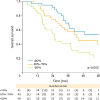1. Jemal A, Bray F, Center MM, Ferlay J, Ward E, Forman D. Global cancer statistics. CA Cancer J Clin. 2011; 61:69–90.
2. Baldwin LA, Huang B, Miller RW, Tucker T, Goodrich ST, Podzielinski I, et al. Ten-year relative survival for epithelial ovarian cancer. Obstet Gynecol. 2012; 120:612–618.
3. Sölétormos G, Duffy MJ, Othman Abu Hassan S, Verheijen RH, Tholander B, Bast RC Jr, et al. Clinical use of cancer biomarkers in epithelial ovarian cancer: updated guidelines from the European group on tumor markers. Int J Gynecol Cancer. 2016; 26:43–51.
4. Elattar A, Bryant A, Winter-Roach BA, Hatem M, Naik R. Optimal primary surgical treatment for advanced epithelial ovarian cancer. Cochrane Database Syst Rev. 2011; (8):CD007565.
5. Chang SJ, Bristow RE. Evolution of surgical treatment paradigms for advanced-stage ovarian cancer: redefining ‘optimal’ residual disease. Gynecol Oncol. 2012; 125:483–492.
6. Yoo SC, Yoon JH, Lyu MO, Kim WY, Chang SJ, Chang KH, et al. Significance of postoperative CA-125 decline after cytoreductive surgery in stage IIIC/IV ovarian cancer. J Gynecol Oncol. 2008; 19:169–172.
7. Zivanovic O, Sima CS, Iasonos A, Bell-McGuinn KM, Sabbatini PJ, Leitao MM, et al. Exploratory analysis of serum CA-125 response to surgery and the risk of relapse in patients with FIGO stage IIIC ovarian cancer. Gynecol Oncol. 2009; 115:209–214.
8. Rosen A, Sevelda P, Klein M, Spona J, Beck A. A CA125 score as a prognostic index in patients with ovarian cancer. Arch Gynecol Obstet. 1990; 247:125–129.
9. Brand E, Lidor Y. The decline of CA 125 level after surgery reflects the size of residual ovarian cancer. Obstet Gynecol. 1993; 81:29–32.
10. Yedema CA, Kenemans P, Thomas CM, Massuger LF, Wobbes T, Verstraeten R, et al. CA 125 serum levels in the early post-operative period do not reflect tumour reduction obtained by cytoreductive surgery. Eur J Cancer. 1993; 29A:966–971.
11. Gadducci A, Landoni F, Maggino T, Sartori E, Zola P, Fanucchi A. The relationship between postoperative decline of serum CA 125 levels and size of residual disease after initial surgery in patients with advanced ovarian cancer: a CTF study. Gynecol Oncol. 1996; 63:234–237.
12. Préfontaine M, Gelfand AT, Donovan JT, Powell JL. Reproducibility of tumor measurements in ovarian cancer: a study of interobserver variability. Gynecol Oncol. 1994; 55:87–90.
13. Chi DS, Ramirez PT, Teitcher JB, Mironov S, Sarasohn DM, Iyer RB, et al. Prospective study of the correlation between postoperative computed tomography scan and primary surgeon assessment in patients with advanced ovarian, tubal, and peritoneal carcinoma reported to have undergone primary surgical cytoreduction to residual disease 1 cm or less. J Clin Oncol. 2007; 25:4946–4951.
14. Lakhman Y, Akin O, Sohn MJ, Zheng J, Moskowitz CS, Iyer RB, et al. Early postoperative CT as a prognostic biomarker in patients with advanced ovarian, tubal, and primary peritoneal cancer deemed optimally debulked at primary cytoreductive surgery. AJR Am J Roentgenol. 2012; 198:1453–1459.
15. Zeillemaker AM, Verbrugh HA, Hoynck van Papendrecht AA, Leguit P. CA 125 secretion by peritoneal mesothelial cells. J Clin Pathol. 1994; 47:263–265.
16. Redman CW, Jones SR, Luesley DM, Nicholl SE, Kelly K, Buxton EJ, et al. Peritoneal trauma releases CA125? Br J Cancer. 1988; 58:502–504.
17. Fleuren GJ, Nap M, Aalders JG, Trimbos JB, de Bruijn HW. Explanation of the limited correlation between tumor CA 125 content and serum CA 125 antigen levels in patients with ovarian tumors. Cancer. 1987; 60:2437–2442.
18. Talbot RW, Jacobsen DJ, Nagorney DM, Malkasian GD, Ritts RE Jr. Temporary elevation of CA 125 after abdominal surgical treatment for benign disease and cancer. Surg Gynecol Obstet. 1989; 168:407–412.
19. van der Zee AG, Duk JM, Aalders JG, Boontje AH, ten Hoor KA, de Bruijn HW. The effect of abdominal surgery on the serum concentration of the tumour-associated antigen CA 125. Br J Obstet Gynaecol. 1990; 97:934–938.








 PDF
PDF Citation
Citation Print
Print






 XML Download
XML Download